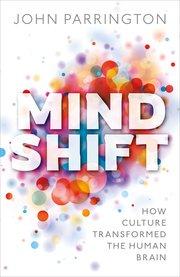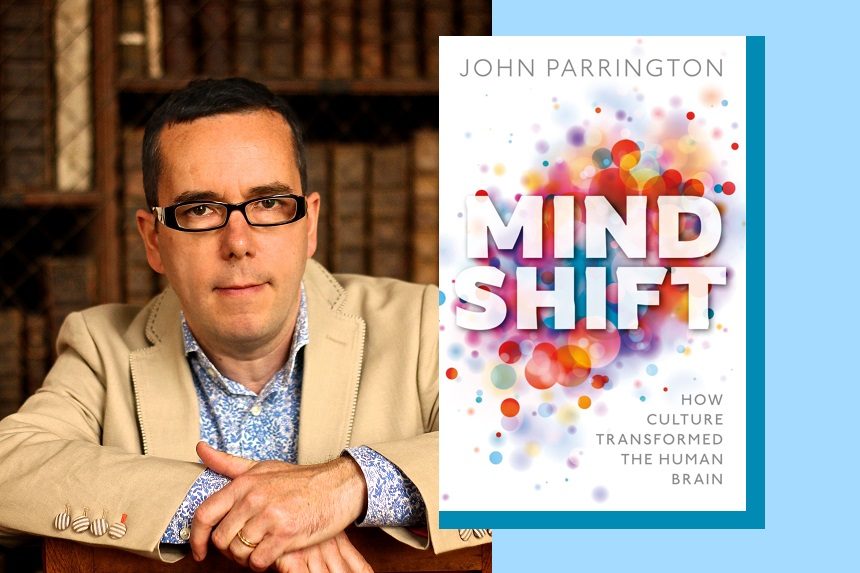When Dr. John Parrington set out to write a book about the intricacies of the human brain and consciousness, his own sister had recently died by suicide at 53 years old. She had spiraled into a deep depression and was unresponsive to treatment. Diving into research on neuroscience and psychology , he also sought to understand his own personal tragedy better.
The result was Mind Shift: How Culture Transformed the Human Brain, published by Oxford University Press last month. Parrington, Professor of Molecular and Cellular Pharmacology and Tutorial Fellow in Medicine at Worcester College at Oxford University, takes an approach to the human brain that considers the complex interplay between biological and sociological factors. His book attempts to reconcile the longstanding enigmas of the human mind with current research to answer some difficult questions: What makes human consciousness unique? How is the structure and function of the human brain affected by the world we’ve built? Why does it go so wrong for so many people?
Parrington believes the key to improving things like education and treatment for depression lies in understanding the ways culture has permanently changed the human brain.
In the days after I had scheduled an interview with Dr. Parrington, I received the news that a friend of mine — a fun-loving, talented jazz musician — had taken his own life. I was shocked, since, as in so many cases, I had no idea he was suffering.
I spoke to Parrington on a video call the day before my friend’s wake. In our conversation, he explained much of the research he had put forth in his book about the unique complexity of the human mind and why, he believes, there is reason to have hope in the midst of a mental health crisis .
Saturday Evening Post: How much would you attribute the current mental health crisis to a broader crisis in healthcare access versus a dearth of brain and mental health research?
Parrington: Here in the U.K., we have the National Health Service, a publicly funded system. If anything, the pandemic has helped to show the importance of funding healthcare in such a way. But there’s no doubt at all that there’s a crisis in the number of beds that are available for someone with a mental disorder or the number of mental health nurses. In the U.S., there’s been a lot of discussion about the lack of provisions for many people with mental disorders and the impact this has in individual terms like the number of suicides per year as well as societal terms with events like mass shootings — which often have an element of mental distress. Of course, in general, people who have a mental disorder are far more dangerous to themselves than to other people.
SEP: How much does “what we don’t know” about the brain and mental illness affect the extent of this crisis today?
Parrington: I think in this sense the mind is quite different than the rest of the body. In general, there have been major advances in medicine: vaccines, surgery, the very effective drugs now available. One of the problems we face with the mind and disorders of the mind is that we still know so little about how the brain works.

In the book I explore some one-sided views of how the mind works. One of these says that it’s all down to genes and biology. On the other hand, you’ve got people who say that biology doesn’t matter at all, as a spokesperson for the British Psychological Society said years ago . And I think both of those views are wrong. There’s an incredibly complex and interactive link between the environment we grow up in and our biology. Individual differences do have an impact on our behavior, our personalities, and the kinds of mental disorders we may be susceptible to. But our environment is incredibly important: what happens in our family life, the pressures of society, racism, sexism, homophobia. All of these have an impact.
So, trying to identify what this complex interaction is, and trying to understand it in terms of brain cells is the real challenge. Although there are drugs available to treat depression and schizophrenia, I think there’s not a good understanding of how they work, even the ones that seem to be effective like SSRIs. There’s a lot of debate about how these drugs actually work, and that’s quite different from drugs we use to treat diabetes and heart disease, or vaccines and antibiotics. That reflects the fact that we don’t understand the brain half as much as we understand the rest of the body.
SEP: In your book, you write that “purely biomedical, or psychological, views of the mind and its disorders both suffer from major flaws that restrict our understanding of how the human brain and mind work.” How would you characterize a happy medium understanding of this “complex interaction” that you’re suggesting?
Parrington: I think that one thing that has changed in human beings compared to other species is that back in our evolution when we first started to diverge from apes, we started to use tools to change the world around us in a systematic way, and this tool-use also began to develop over generations. Although there are other species, like other primates and crows, that use tools, I don’t think they do it in a systematic way that develops over time as we do.
That’s one big difference. Another difference is that we developed language. Although other animals communicate, human language is very different in that it communicates complex concepts through words which are abstract symbols, essentially.
The human brain developed to become much larger than in other primates. In my book, I argue that there’s been a radical restructuring of the brain that’s happened as well. That, I think, is kind of an accepted thing, but what I wanted to look at is how that works in the brain in terms of brain cells, in terms of regions of the brain developing new connections. What is different about the brain from the development of language and tools?
SEP: What exactly is the “radical restructuring” that you’re talking about? Evolution?
Parrington: Partially, yes. The way the human brain works, I’ve argued, is radically different than in other species, and that happened over millions of years in evolution. But also, what I think is different about human beings is that our brains also become radically restructured as we grow up through our interactions with other human beings, particularly through language. Art, literature, those cultural tools transform the brain as we develop into adults. If you left a baby in the jungle, like Mowgli, to be raised by wolves, that person would never learn to be human in the sense that they would ever be able to communicate complex ideas and concepts. We need that sort of interaction for our brains to develop in that particular way.
The challenge, then, is to find how that affects our brain biology, the ways that the individual neurons, glial cells, and brain regions work and connect together. We face a challenge, because a lot of the studies we do, in terms of brain function, are done on animals, for good reason. But I do believe there are some major differences at all levels in the human brain, and those are what I’ve tried to identify in the book.
SEP: You bring up a lot of different studies and research in your book. Which of those could help someone understand how this “radical restructuring” of the brain is tied to language?
Parrington: Two people who I mention in the book — Lev Vygotsky and Valentin Voloshinov, who worked in Russia in the 1920s and ’30s — had interesting ideas about words and consciousness. They studied how “inner speech” connected thought and exterior language, but also how that is socialized. So, there’s a dialogue going on in our minds, essentially. Our inner speech has that kind of dimension, and it’s a dialogue that brings in all these influences that we’ve grown up with. That research occurred almost 100 years ago, and what I wanted to do in the book was to link those basic ideas with how neurons and glial cells work.
Some things that I found quite interesting were evidence of connections in parts of the brain that seem to be quite specific to humans. Glial cells stretch further in the brain and connect different regions than you would see in a chimpanzee. Then there’s the cerebellum, which was previously only thought to be involved in movements like playing the piano or throwing a ball through a hoop, but now there’s new evidence to suggest it also plays a role in creativity and imagination. It seems to do that by linking up to higher regions of the brain, like the prefrontal cortex, in a way that’s radically changed the brain.
SEP: Did Lev Vygotsky first describe the phenomenon of “inner speech” or inner dialogue?
Parrington: Valentin Voloshinov also came up with this idea of inner speech being a dialogue, as well as stressing its social dimension, this way in which different voices from our past can structure the ways we think. So, our minds are very much social as well as individual entities.
There have also been other people, especially in the United States, who have picked up on some of Vygotsky’s ideas and developed them in an educational sense. There were some interesting experimental studies done in New Mexico where they looked at using these ideas to make some radical interventions in education. Instead of the idea that a child has a fixed ability, they looked at the potential that exists for that child to develop in all sorts of surprising ways. But it really requires the “scaffolding” of teachers, parents, carers, and also peers, for a child’s mind to be developed with social interaction.
SEP: Besides the New Mexico studies, do you see those ideas gaining traction in the field?
Parrington: I’m not sure about the U.S., but certainly in the U.K. there’s been a move away from more progressive ideas about how to educate children. The government at the moment, and the national curriculum, stresses that children should be learning facts and there’s been a move away from the idea that projects and experiments are the ways that children really learn. Instead of novels and stories, it’s facts and chunks of text. That kind of thing.
Vygotsky’s ideas were more reflected in the styles of education that were more popular in the ’60s and ’70s. Vygotsky’s work was rediscovered then by some U.S. psychologists, particularly Richard Cole, and it became quite popular in the ’70s in particular. It would seem to link to a more progressive way of looking at education: seeing every child as having potential and seeing that social interaction as key to learning, making school more exciting and interesting.
SEP: These insights that you’re talking about — and that you’ve outlined in your book — about the unique evolution and development of the brain, how do you think they can inform mental health treatment?
Parrington: What I wanted to do was to look at major conditions like depression and schizophrenia alongside evidence that’s accumulating like biological links. It’s not that I ignore the biological aspects of things; I’m very much interested in those, and I think there are some interesting genetic links emerging for those conditions. We are finding that certain people have susceptibilities to things like schizophrenia from a genome that is slightly different, but we are also finding that it’s an incredibly complex link. There are no obvious “schizophrenia genes” or “depression genes;” it simply doesn’t work like that. I think what we’re also starting to realize is that this complex interaction between environment and biology is a constantly evolving one. It’s not easy to say “well, this part is from biology and this one from society, 50:50 or 60:40.”
For instance, I think there have been some really interesting ideas put forward about the social genesis of schizophrenia. So R.D. Laing, a British psychologist in the late ’60s and early ’70s described how dysfunctional family environments can have a big impact on schizophrenia development in individuals. What we are starting to learn now is that traumas — social trauma, family trauma — do seem to have an impact in terms of biology. There are some interesting links between inflammation in the brain and schizophrenia. That inflammation can be caused by physical trauma, but also social trauma. We need to understand how that link develops in an individual, but also then how we can develop drugs that target these changes. At the same time, how can we treat the dysfunctional social environment that may have led to it?
I wrote about a method that was developed in Finland called “Open Dialogue.” That’s an interesting approach where they bring in family members. So, rather than just trying to treat the patient with psychotherapy, they bring in the family so that they are also part of the approach. Often, family relations are linked to these conditions. It sort of goes back to the social dimension of inner speech. With open dialogue, drugs and psychotherapy can be used together. But I think that if we do want to use drugs to treat mental disorders, we need a better understanding of what’s going on in the brain, how social restructuring of the brain might break down with a disorder, the impact on individual neurons and glial cells, and how drugs can feed into that.
SEP: You mentioned the Finland treatment model. Are there any others, new or forthcoming, that you think might approach that complex interaction of biology and environment in a more effective way?
Parrington: There are others. In the U.K., there are therapies that rely on allowing patients to make art or music. That goes back to something I write about quite a lot in the book, which is the importance of meaning. Human beings, in particular, we make meaning of the world around us through words and concepts. What Vygotsky called “cultural tools,” which include language but also music and art, allow us to explore meaning — such as the meaning of ourselves and our place in the world — and, in the case of mental disorder, what it all means when it seems to be falling apart.
Earl Miller, a neuroscientist at MIT, has done some interesting work studying brain waves at different frequencies and how they help to coordinate different regions of the brain, pulling together such regions in a dynamic fashion. And this is a constantly changing relationship. This kind of helped me to understand more about how the human mind might be different than that of an ape. It struck me that if language has this major restructuring role in consciousness, then maybe one of the ways it works is using brain waves to pull together these parts of the brain and working to coordinate their function.
I think there’s a lot to be gained in the future by using brain imaging to capture the relationships, mediated by brain waves, between different parts of the brain and perhaps use that as a way to test the success of psychotherapy or drugs.
SEP: Most people, if not all people, are affected by mental illness. What do you think lay people should understand most of all about the brain and consciousness as they relate to mental health?
Parrington: One thing we do increasingly realize is that there is a thin line between creative genius and mental disorder. I think we’re starting to recognize that with disorders like ADHD or autism spectrum disorder, there is often a very positive side to some of these disorders. People with these conditions often have very creative, thoughtful, and imaginative minds. I think this might apply in some way to all such disorders. By labelling them purely as disorders, we might miss some of the exciting and interesting ways that some people think compared to others.
Seeing that there is a spectrum of human behavior, personality, and intelligence is important. Having said that, people have severe forms of depression, like my sister did, or autism or schizophrenia that are incredibly debilitating and prevent them from living a normal life. I think we need more sensitivity toward people behaving differently while recognizing that the more extreme ends of these disorders require treatment.
I think one of the most interesting things about being human is that our brains are much more plastic, much more open to learning and change even into adulthood, than we used to think. So, a positive aspect of that is that even in cases of severe disorder, there is potential for recovery. The more we learn about those interconnections between the social and biological aspects of the mind, the more we can start to treat disorders in a more targeted way. That does require a radical change in the approach we have to the human mind, one that sees it as unique, biologically, from other animals.
SEP: You’ve had a very close experience with mental illness and suicide with your sister, who suffered from depression and took her own life. How has that affected your approach to this research?
Parrington: It’s affected it quite a bit. My sister committed suicide. My father died in odd circumstances: an accident that didn’t really make sense. My grandmother died by drowning in the canal. So, I’ve had to deal with these tragedies in my own life. I think it was kind of difficult to write the book without bringing this in, because it is personal and these events reverberate effects across many individuals. As you know, the shock and horror that comes with someone ending their own life is very hard to deal with.
I think what I wanted to do with the book was to look at ways of dealing with that sort of thing, and I was inspired by stories of other people. I found it interesting the ways that different people deal with those kinds of tragedies. One woman I mention in the book, Ida Keeling, from New York, in her 60s lost both her sons to drug violence and still managed to keep herself from cracking up and going under. In her case, it was taking up running that helped her (I look at how exercise can stimulate natural endorphins that can boost mental health), but there are many potential ways that might help an individual cope with severe personal trauma.
I thought in writing the book that I might come to an understanding of why my sister died and, unfortunately, I’m not much nearer to an answer. She was a happy, sociable person, and when she did slide into this horrible, severe depression, none of the drugs or psychotherapy worked. It made me realize how much there is this deficit there: there’s actually a quite large number of people with severe depression who don’t respond to Prozac or other drugs, who don’t respond to psychotherapy. It made me realize how much more we need to know to help people with those serious conditions.
Featured image: Photo by Anthony Morgan, Mind Shift, Copyright © Oxford University Press 2021
Become a Saturday Evening Post member and enjoy unlimited access. Subscribe now




Comments
Great new feature, Nicholas. The brain is so complex that (in 2021) although we seem to know a lot, we’re just scratching the surface really. Dr. Parrington, my condolences to you on the loss of your sister as described. There are so many factors known and unknown beyond heredity and environment, but these two still seem the most dominant.
The number of children today (mostly male) that have autism is staggering and shocking. Yet there are their Mom’s with an endless supply of Diet Coke’s in her shopping cart. A single source in itself of some of the worst chemicals a person can consume, not to mention all of the toxic things our greedy government allows in our food and drinks, banned in other countries.
Then there’s all the stress of modern life (here) where our thoughts are constantly under siege by the loud, screaming media, overstimulation saturation and noise/air pollution. For most of human history people were more advanced than the technology they had to work with, and surrounding them. By the mid 20th, we had everything we needed really, for a modern, comfortable life. The greatest and most important technology has been in medical advances, not the largely unnecessary garbage so fussed over that’s overall made life harder, complicated, less healthy and more stressful. Technology has overtaken us, and is in charge.
Mankind is now hanging over a cliff of complete destruction by climate change due to greed at any cost, laid bare on all fronts during this pandemic. The reigns of control need to be taken away from those in control or trying to figure out people’s brains will be too little too late. Just look at how people have devolved in their behavior over the past 20+ years. Armed guards necessary on regular air flights, or at children’s little league games? YES, unfortunately. People attacking others for wearing the mask, just trying to be safe? Yes. The list goes on and on.
Even if Covid ends, the mental health disaster is just starting. Like our endless wars (purely for profit) endless pandemics, with the suicides, murders and psychological damage may also be permanent. Even if solutions are found, our government will intentionally ruin it, as always. Chaos is in their best interest. These are uncharted waters, we’re in a lot of trouble, and the government is at the heart of all of it.